Articles
- Page Path
- HOME > Perspect Integr Med > Volume 2(1); 2023 > Article
-
Original Article
An Observational Study on the Anatomical Characteristics of Acupoint CV23 (Lianquan) with Ultrasonography -
Hongmin Chu1,2,†
 , Seongjun Park3,†
, Seongjun Park3,† , Jaehyo Kim3
, Jaehyo Kim3 , Wonbae Ha4
, Wonbae Ha4 , Seung Bum Yang5
, Seung Bum Yang5 , Kyungho Kang6
, Kyungho Kang6 , Jongho Kim2
, Jongho Kim2 , Jungtae Leem1,7
, Jungtae Leem1,7 , Sanghun Lee8,*
, Sanghun Lee8,*
-
Perspectives on Integrative Medicine 2023;2(1):49-55.
DOI: https://doi.org/10.56986/pim.2023.02.007
Published online: February 21, 2023
1College of Korean Medicine, Wonkwang University, Iksan, Republic of Korea
2Paju Public Health Center, Paju, Republic of Korea
3Department of Meridian and Acupoint, College of Korean Medicine, Wonkwang University, Iksan, Republic of Korea
4Department of Rehabilitation Medicine of Korean Medicine, College of Korean Medicine, Wonkwang University, Iksan, Republic of Korea
5Department of Medical Non-Commissioned Officer, Wonkwang Health Science, Iksan, Republic of Korea
6Yangjae Cheongwoo Korean Medicine Clinic, Seoul, Republic of Korea
7Korean Traditional Medicine Institute, Wonkwang University, Iksan, Republic of Korea
8Future Medicine Division, Korea Institute of Oriental Medicine, Daejeon, Republic of Korea
- *Corresponding author: Sanghoon Lee, Future Medicine Division, Korea Institute of Oriental Medicine, 1672 Yuseong daero, Yuseong gu, Daejeon 34054, Republic of Korea, E-mail: ezhani@kiom.re.kr
- † The authors contributed equally.
©2023 Jaseng Medical Foundation
This is an open access article under the CC BY-NC license (http://creativecommons.org/licenses/by-nc/4.0/)
- 1,109 Views
- 33 Download
Abstract
-
Background
- Acupoint CV23 is one of the most commonly used acupoints for the treatment of post-stroke dysphagia and tongue pain. However, care must be taken during the procedure to consider the position of glands and blood vessels in the subcutaneous space of the acupoint. Needling depths to the geniohyoid muscle reportedly range from 0.4 to 3.3 cm. Using ultrasound imaging, we aimed to observe the anatomical characteristics around acupoint CV23 to derive a safe needling depth.
-
Methods
- Ultrasound images of acupoint CV23 accessed from the Standard Ultrasound Image of Acupoint database were retrospectively analyzed for 30 participants aged in their 20s and 30s (15 male, 15 female), and the depth from the skin to the geniohyoid muscle was measured. Correlations between the needling depth and anthropometric factors (such as neck circumference) were analyzed.
-
Results
- The average needling depth to the geniohyoid muscle was 1.59 ± 0.49 cm (male; 1.43 ± 0.52 cm, female, 1.75 ± 0.42 cm, p = 0.03). The geniohyoid muscle, anterior digastric muscles, and genioglossus muscle were observed in the subcutaneous area of acupoint CV23, and a risk of sublingual gland damage needs to be considered for oblique insertion of the acupuncture needle. No statistically significant correlations between the needling depth and anthropometric factors were observed.
-
Conclusion
- Acupoint CV23 has a relatively shallow needling depth, and considering the presence of blood vessels and glands in the sublingual space, visualizing the surrounding anatomical structures using ultrasound was helpful to ensure safe needling practice.
- Ultrasound is actively applied for safe and effective acupuncture treatment, and education and training of acupuncture [1,2]. The use of ultrasound during acupuncture has the advantage of preventing damages to vulnerable structures in close proximity to the acupoints and enables precise stimulation for the target structure. In addition, the use of ultrasound facilitates rapid improvement in acupuncture skills in practitioners early on in their acupuncture training, through real-time visualization of anatomical structures [2].
- Previous studies suggest that rather than using a set depth for needling it is safer to use anthropometric measurements (such as neck circumference and shoulder width) and ultrasound guidance [1,3]. For example, in the case of obesity a high correlation was observed between the use of ultrasound and safe needling practice [1,3]. In a study on acupoint CV12, the liver was observed in 62.7% of the patients’ ultrasound images [4]. Therefore, the use of ultrasound for deep needling to acupoint CV12 may prevent organ damage.
- Acupoint CV23 is an acupoint frequently used for improvement of dysphagia, a type of post-stroke sequela named “Lianquan” or “Yeomcheon” [5,6]. A previous study recommended deep needling for acupoint CV23 to have a positive effect on dysphagia [5].
- Therefore, this study aimed to retrospectively analyze the anatomical characteristics of acupoint CV23 by using ultrasound images from the “Standard Ultrasound Image of Acupoint Database (SUA Database),” to suggest a safe needling depth at acupoint CV23.
Introduction
- 1. Standard ultrasound image using the standard ultrasound image of acupoint database
- Three clinical studies were conducted for construction of the “Standard Ultrasound Image of Acupoint (SUA) database.” [1,3,7] In brief, these studies were conducted in healthy participants in the 20s and 30s age groups. A multidisciplinary specialty research team composed of specialties such as Korean medicine rehabilitation, acupuncture and moxibustion medicine, and pathognomy, selected 44 high-risk acupoints and established a standard operating procedure for acquisition of SUA [7]. Two clinical studies were conducted to acquire 44 “high-risk acupoint” images, and an additional clinical study was conducted for acquisition of images for acupoint GB21. These studies for “high-risk acupoints” were conducted between 16 and 26 November 2015 and 1 August and 13 September 2016 at the College of Korean Medicine, Wonkwang University, Iksan, Korea (WKIRB-201510-BM-001 and WKIRB-201606-SB-033). These clinical studies are registered at the Clinical Research Information Service [CRIS; Osong (Chungcheongbuk-do)]: Korea Centers for Disease Control and Prevention, Ministry of Health and Welfare (Korea) KCT0002498 and KCT0002506. In the first clinical study (KCT0002498), the images of acupoints LU1, CV14, GB25, CV4, SP11, CV15, SP14, CV23, ST9, GB24, LR13, CV12, CV22, CV20, and ST25 were taken. In the second study, ST6, ST7, SI19, TE17, GV15, GV16, GB20, GV14, GB21, SI14, BL12, GV12, BL13, BL15, GV9, BL17, BL46, BL21, BL50, GV4, BL23, BL52, GV3, BL25, BL31, BL32, BL33, BL34, GB30 and CV12 were measured. The study on acupoint GB21 was conducted between August 1 and September 13, 2016, at the College of Korean Medicine, Wonkwang University, Iksan, Republic of Korea. This study was approved by the Institutional Review Board (IRB), and was registered at CRIS (WKIRB-201607-BM-039, KCT0002526).
- As such, the SUA database contains ultrasound images of LU1, CV14, GB25, CV4, SP11, CV15, SP14, CV23, ST9, GB24, LR13, CV12, CV22, CV20, and ST25 measured in 30 patients, and 60 patients. ST6, ST7, SI19, TE17, GV15, GV16, GB20, GV14, GB21, SI14, BL12, GV12, BL13, BL15, GV9, BL17, BL46, BL21, BL50, GV4, BL23, BL52, GV3, BL25, BL31, BL32, BL33, BL34, GB30 and CV12 ultrasound images (KCT0002498 and KCT0002506). In the case of acupoint GB21, 52 additional patients were measured (KCT0002526). In each clinical trial, the experiment was conducted by measuring several acupoints for one subject.
- In this way, the SUA database was built, and secondary utilization of the results from these studies was obtained from Wonkwang University IRB (WKIRB-202205-SB-039).
- In this study, 30 CV23 images were analyzed by extracting data on acupoint CV23, a frequently used acupoint (rarely studied using ultrasound) from the SUA database.
- 2. Location of acupoint CV23
- Acupoint CV23 is located in the anterior region of the neck, superior to the superior border of the thyroid cartilage, in the depression superior to the hyoid bone, on the anterior median line. When obtaining ultrasound images of acupoint CV23, the researcher reported that the participant’s head was led slightly into an extended position, and palpated the hyoid tubercle between the mandible and the thyroid cartilage [7]. Fig. 1 shows the position of acupoint CV23.
- 3. Ultrasound image of acupoint CV23
- Ultrasound images of acupoint CV23, were obtained using an ultrasound machine, GE voluson 730 expert (General Electric Co., Boston, MA, USA), and linear ultrasound probes (2D linear array Transducers, General Electric Co., Boston, MA, USA). The probe’s placement for ultrasound is shown in Fig. 2A.
- 4. Analysis and measurement
- The measurement of the maximal safe needling depth of CV23 was defined as the distance between the surface of the skin and geniohyoid muscle, which could be measured using ultrasound imaging. The probe angle was vertical to the skin over CV23 and parallel to the transverse plane. The distance was measured using the scale mounted on the ultrasound device. For the interpretation of ultrasound images of acupoint CV23, we referred to previous studies on radiological, anatomical, and ultrasound investigations for the sublingual and submandibular spaces [8–10]. The geniohyoid-genioglossus muscle complex is observed in the subcutaneous space of acupoint CV23, and paired anterior digastric muscles lie in front of this muscle complex (Figs. 2B and 2C).
- 5. Measurement of anthropometric parameters and correlation analysis
- Several anthropometric parameters like height, weight, chest circumference, neck circumference, shoulder width, hip circumference, subcutaneous fat thickness were measured in the previous clinical studies (KCT0002498 and KCT0002506) used to set up the SUA database [7]. For calculating correlation between needling depth and anthropometric factors, we extracted data for “neck circumference,” “BMI,” “thickness of abdominal subcutaneous adipose tissue” and “length of handbreadth (3 cun).” A correlation between depth to the geniohyoid muscle and anthropometric parameters was derived. The correlations between the depth of acupoint CV23 and BMI, neck circumference, fat thickness (abdomen) and “length of handbreadth (3 cun)” were calculated.
- 6. Statistical analysis
- R Version 1.0.143 software was used for statistical analysis (R Studio, Boston, MA, USA). Continuous variables were expressed as means (standard deviations) or medians, whilst categorical variables were expressed as numbers and percentages of patients (quartiles). Pearson’s correlation coefficient was used to calculate the relationship between the depth of the CV23 acupoint and the anthropometric markers. A p < 0.05 was considered significant.
Materials and Methods
- 1. Characteristics of the participants
- This study included the data from 30 volunteers (15 male and 15 female) ranging in age from 19 to 32 years old which was obtained from the SUA database. Ultrasound images of acupoint CV23 were obtained for all individuals (Fig. 3).
- 2. Needling depth of acupoint CV23
- The needling depth of acupoint CV23 was defined as the distance from the surface of the skin to the surface of geniohyoid muscle. The thickness of the participants subcutaneous fat was calculated separately. Table 1 shows the characteristics and needling depth for the participants. The average depth to the geniohyoid muscle was observed to be deeper in female participants than their counterparts due to the difference in the thickness of subcutaneous fat. As a secondary factor for measurements of needling depth, the depth to the anterior digastric muscles was measured. To measure the depth to reach the geniohyoid muscle, which is the needling target of acupoint CV23, the depth of the area was measured as the depth to muscle penetration. Since the anterior digastric muscles have a bilateral symmetrical shape, the depths to the two muscles were averaged to be used as the measurement value, and the values for the left and right sides were also presented (Table 1).
- 3. Correlation between needling depth and anthropometric parameters in the study group
- Correlation coefficients between depth to the geniohyoid muscle and anthropometric parameters [BMI, neck circumference, fat thickness (abdomen) and “length of handbreadth (3 cun)”] were derived. The correlation coefficient between BMI and needling depth (ND) was 0.40 (p = 0.69), neck circumference and ND was −0.16 (p = 0.39), fat thickness and ND was 0.23 (p = 0.20). The length of handbreadth and ND was −0.11 (p = 0.53). Among these anthropometric parameters, statistically significant correlations were not observed. (Table 2; Fig. 4).
Results
- Acupoint CV23, also called Lianquan or Yeomcheon, is one of the most commonly used acupoints for post-stroke rehabilitation in dysphagia. Acupoint CV23 is used to decrease muscle movement in the region from the mouth to the esophagus or problems in the central nervous system [6]. Indications or the use of acupoint CV23 include tongue swelling with difficulty in speaking, protracted tongue, and acute contraction of the tongue root [11].
- In fact, among therapy for swallowing in post stroke dysphagia, research related to treatment using acupuncture has attracted the most active interest among interventional methods, and its effectiveness has also been reported to be excellent [12]. Acupoint CV23 is used for improvement of dysfunction in swallowing, and electro-acupuncture or deep needling are recommended treatments [5,13]. The needling depth for acupoint CV23 has been reported as not exceeding a depth of 0.75 cm, a depth between 0.4–0.5 cm, and a depth between 0.8–1 cun (converted to 2.4–3.3 cm) [5,6,11]. This study extracted acupoint CV23 images (n = 30) from the previously constructed SUA database for analysis for a quantitative determination of the results to compare with these previous studies.
- The adjacent structures in the needling of acupoint CV23 lie in the sublingual space and therefore, if oblique insertion is performed passing the mylohyoid muscle rather than insertion into the geniohyoid muscle, there is a risk of damage to the sublingual gland. In addition, since there are also acupuncture methods with various stimulation of the sublingual space as well as the acupoint CV23, as in the case of “three tongue needling”, not only the depth to the geniohyoid muscle but also the depth to the anterior digastric muscles is important and so, this measurement was performed in this study [6].
- As a result of the needling depth analysis in this study, the needling depth to reach the geniohyoid muscle from acupoint CV23 was 1.59 ± 0.49 cm, and the depth was deeper for female participants due to the thickness of subcutaneous fat, and the difference was statistically significant (male; 1.43 ± 0.52 cm, female, 1.75 ± 0.42 cm, p = 0.03). This result of needling depth is less than the traditional needling depth of 1 cun (3.33 cm), but more than the needling depth of 0.75 cm suggested in previous literature [5,6,11]. The results from this study indicate the necessity of the appropriate needling depth to produce the proper stimulation in the geniohyoid muscle. In addition, acupuncture in acupoint CV23 may stimulate muscles when inserted into the skin at an angle of 90°, but may unintentionally stimulate sublingual glands or blood vessels if the needling direction is misaligned; thus, the practitioner would benefit from visualizing the anatomical structures by using through ultrasound.
- Ultrasonography may also be beneficial in minimizing side events during acupuncture treatments as well as educational benefits of correct needle positioning [14–17]. This study is significant in that it is the first study to analyze the needling depth and anatomical characteristics of acupoint CV23 using ultrasound. In addition, the determination that a characteristic of acupoint CV23 (different from other acupoints) is that it does not show a correlation with BMI or anthropometric factors [3,4]. Therefore, rather than predicting the needling depth according to the patient’s BMI for example, without consideration of individual cases, visual observation of the surrounding anatomical structures with ultrasound is expected to contribute to the safe practice of acupuncture procedures.
- However, there are limitations to this study. The study was conducted on participants in their 20s and 30s; thus, there is a limitation of the difficulty in applying the needling depth derived from this study to the elderly or adolescent populations. In addition, there was a statistically significant difference in the needling depth between women and men, but the value was about 0.2 cm; therefore, it may be considered that in actual clinical practice there is no difference. In future studies, it is necessary to increase the number of sample data and expand the age group range to the elderly and adolescents.
Discussion
- As a result of the ultrasound-based observational study for CV23 (Lianquan), an acupoint in the sublingual space, the average needling depth was 1.59 ± 0.49 cm, and no correlation between the needling depth and anthropometric factors was observed. Acupoint CV23 has a relatively shallow needling depth of less than 2 cm, and considering the presence of blood vessels and glands in the sublingual space, visualization of surrounding anatomical structures through ultrasonography is expected to be helpful for safe needling practice of acupoint CV23.
Conclusion
-
Author Contributions
Wrote manuscript: HC and SP; Conducted the clinical practice and wrote the application for the ethical approval: JK, SP, HC, WH; Organized all procedures and revised the protocol: SL. All authors have read and agreed to the publishing of this version of the manuscript.
-
Consent Statement
Written informed consents was obtained from all participants in the previous studies that formed the SUA database.
-
Conflicts of Interest
The authors declare no conflict of interest. The funders had no role in the design of the study; in the collection, analyses, or interpretation of data; in the writing of the manuscript, or in the decision to publish the results.
-
Ethical Statement
This study was approved by the Institutional Review Board (IRB) of Wonkwang University, Iksan city, Korea (WKIRB-201510-BM-001 and WKIRB-201606-SB-033). This clinical trial was registered at CRIS [https://cris.nih.go.kr/ (accessed on 31 May 2022)] Identifier: KCT0002498 and KCT0002506.
-
Data Availability
The datasets used and/or analyzed during the current study are available from the corresponding author on reasonable request.
-
Funding
This research was supported by the “Development and commercialization of magnetic field acupuncture needle guide ultrasonic system” (KSN1713503) and “Collection of Clinical Big Data and Construction of Service Platform for Developing Korean Medicine Doctor with Artificial Intelligence” (KSN2021110) funded by the Korea Institute of Oriental Medicine. The Korea Institute of Oriental Medicine provided necessary financial support from design to completion of the study (including collection, analysis, interpretation, and presentation of data).
Article information
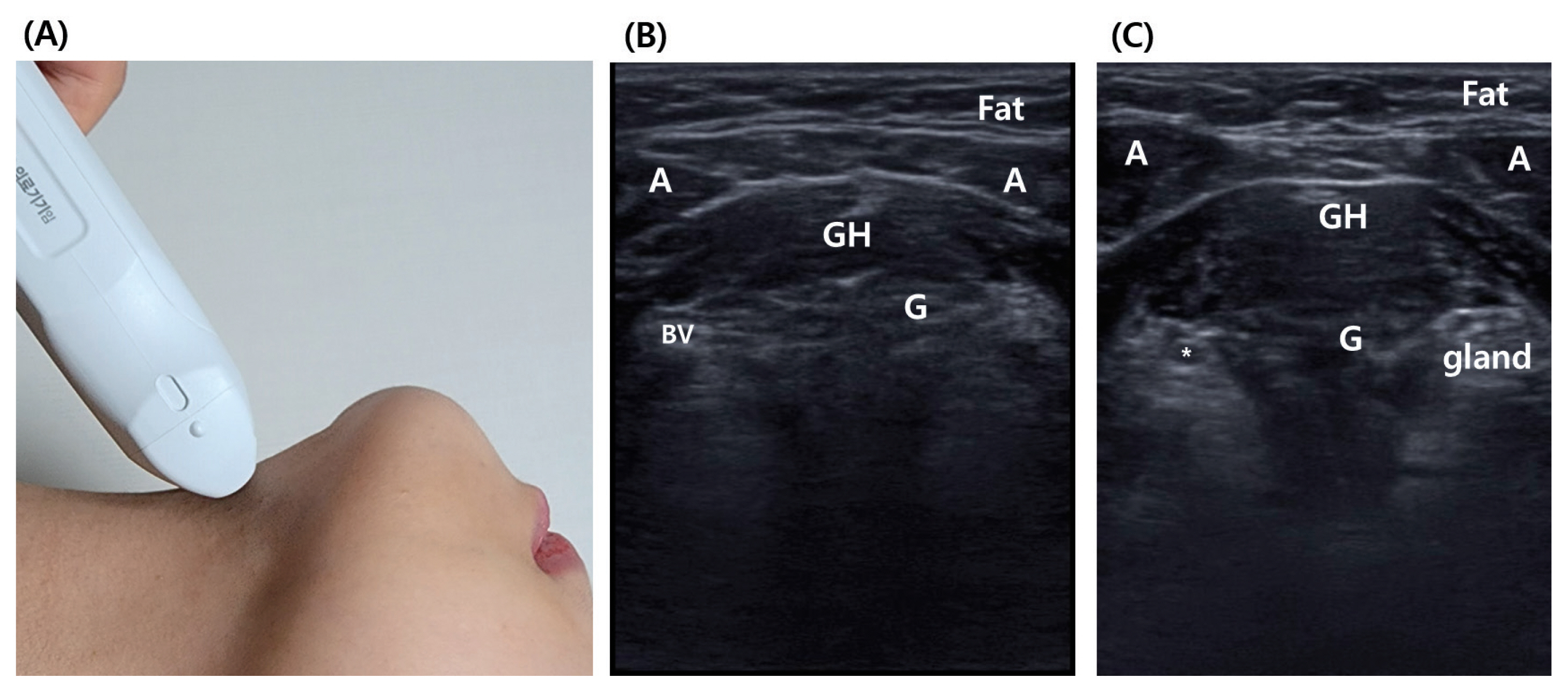
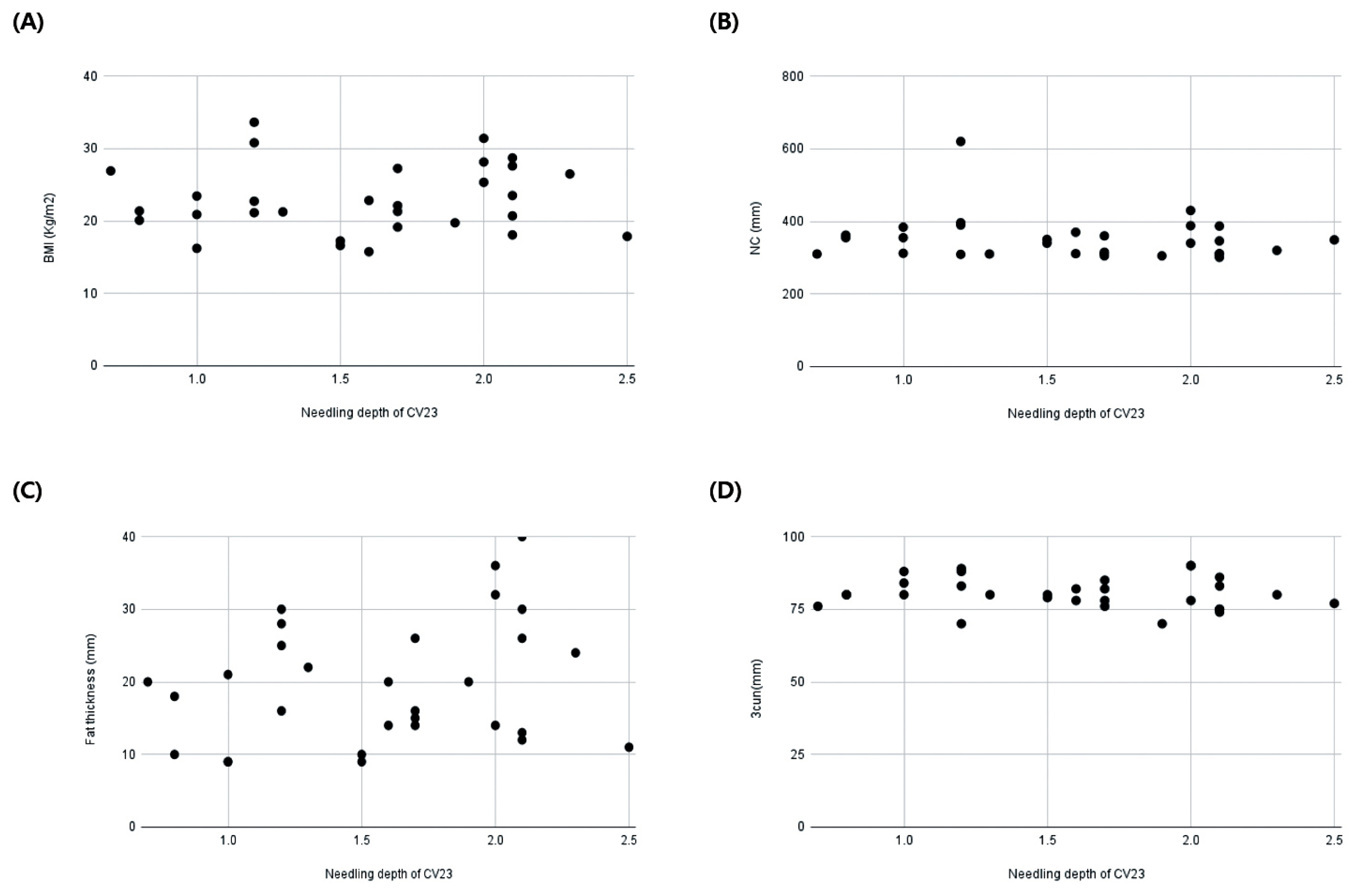
| r-correlation coefficient | p | |
|---|---|---|
| BMI and ND | 0.40 | 0.69 |
| NC and ND | −0.16 | 0.39 |
| FT and ND | 0.23 | 0.20 |
| 3 cun and ND | −0.11 | 0.53 |
- [1] Chu H, Kim J, Ha W, Cho E, Kang G, Park S, et al. Change of Safe Needling Depth at Acupoint GB21 according to Posture and Breathing. Edited by Cherniack EP: Evid Based Complement Alternat Med. 2018, 2018:p 2308102. ArticlePubMedPMCPDF
- [2] Leow MQH, Cui SL, Mohamed Shah MTB, Cao T, Tay SC, Tay PKC, et al. Ultrasonography in Acupuncture–Uses in Education and Research. J Acupunct Meridian Stud 2017;10(3):216−9.ArticlePubMed
- [3] Chu H, Kang G, Park S, Kim J, Jang J, Park K, et al. Determining maximal safe needling depth based on anthropometric measurements: Focusing on acupoint GB21. Eur J Integr Med 2018;21:11−5.Article
- [4] Chu H, Kim J, Park S, Kim J, Lee JH, Ha WB, et al, An Observational Study. Using Ultrasound to Assess Allowable Needle Insertion Range of Acupoint CV12. Healthcare (Basel) 2022;10(9):1707. PubMedPMC
- [5] Qin L, Zhang X, Yang X, Cui C, Shi J, Jia C. Deep acupuncture of Lianquan (CV23) and Yifeng (TE17) in combination with conventional acupuncture of other acupoints is superior to swallowing rehabilitation training in improving post-stroke dysphagia in apoplexy patients. Acupunct Res 2019;44(2):144−7.Article
- [6] Xuewei Z, Minghui L, Minru Z, Qianqian C, Jianfeng W. Effect of three tongue needles acupoints Lianquan (CV23) and Hegu (LI4) combined with swallowing training on the quality of life of laryngeal cancer patients with dysphagia after surgery. J Tradit Chin Med 2022;42(4):617−21.PubMedPMC
- [7] Kim S, Lee S, Ha WB, Lee JH, Jung HJ, Chu HM, et al. Development of an ultrasound-imaging procedure and acquisition of ultrasound images of acupuncture points for safety and accuracy of needle insertion. Integr Med Res 2017;6(4):427−33.ArticlePubMedPMC
- [8] Patel S, Bhatt AA. Imaging of the sublingual and submandibular spaces. Insights Imaging 2018;9(3):391−401.ArticlePubMedPMCPDF
- [9] Kyung DS, Lee JH, Lee YP, Kim DK, Choi IJ. Bilateral variations of the head of the digastric muscle in Korean: a case report. Anat Cell Biol 2011;44(3):241−3.ArticlePubMedPMC
- [10] La’Porte SJ, Juttla JK, Lingam RK. Imaging the Floor of the Mouth and the Sublingual Space. Radiographics 2011;31(5):1215−30.ArticlePubMed
- [11] jun Deng M, Liu CY, Xie Y, Zhu JB, Xu ZH. Regularity of Clinical Application of Lianquan (CV 23) in Chinese Ancient Times According to Literature of Traditional Chinese Medicine. Zhen Ci Yan Jiu 2018;43(3):194−8. [in Chinese]..PubMed
- [12] Bath PM, Lee HS, Everton LF. Swallowing therapy for dysphagia in acute and subacute stroke. Cochrane Stroke Group. Cochrane Database Syst Rev 2018;10(10):CD000323. ArticlePubMedPMC
- [13] Shi J, Ye Q, Zhao J, Liu J, Xu Z, Yi W, et al. EA promotes swallowing via activating swallowing-related motor neurons in the nucleus ambiguus. Brain Res 2019;1718:103−13.ArticlePubMed
- [14] Cho E, Han YM, Kang Y, Kim JH, Shin MS, Oh M, et al. Implementation of Objective Structured Clinical Examination on Diagnostic Musculoskeletal Ultrasonography Training in Undergraduate Traditional Korean Medicine Education: An Action Research. Diagnostics (Basel) 2022;12(7):1707. ArticlePubMedPMC
- [15] Cho E, Han YM, Kang Y, Kim JH, Shin MS, Oh M, et al. Development of an Objective Structured Clinical Examination Checklist and a Post-Education Questionnaire for Musculoskeletal Ultrasound Training Focusing on Volar Wrist and Carpal Tunnel Syndrome. J Acupunct Res 2022;39(2):105−14.ArticlePDF
- [16] Birkholz SE, Patil AA, Chamczuk AJ. Treatment of postoperative recurrent cerebrospinal fluid leak with pseudo-meningocele formation using temporary epidural drain. Interdiscip Neurosurg 2019;16:25−8.Article
- [17] Kim JU, Kim BH, Kim SH, Shin JH, Choi YM, Song BY, et al, A Pilot Clinical Study on the Accuracy and Safety of Ultrasound-guided Gyeontonghyeol (BP-LE6) Acupuncture. A Prospective Randomized, Single Blinded Crossover Study. J Acupunct Res 2019;36(4):272−6.ArticlePDF


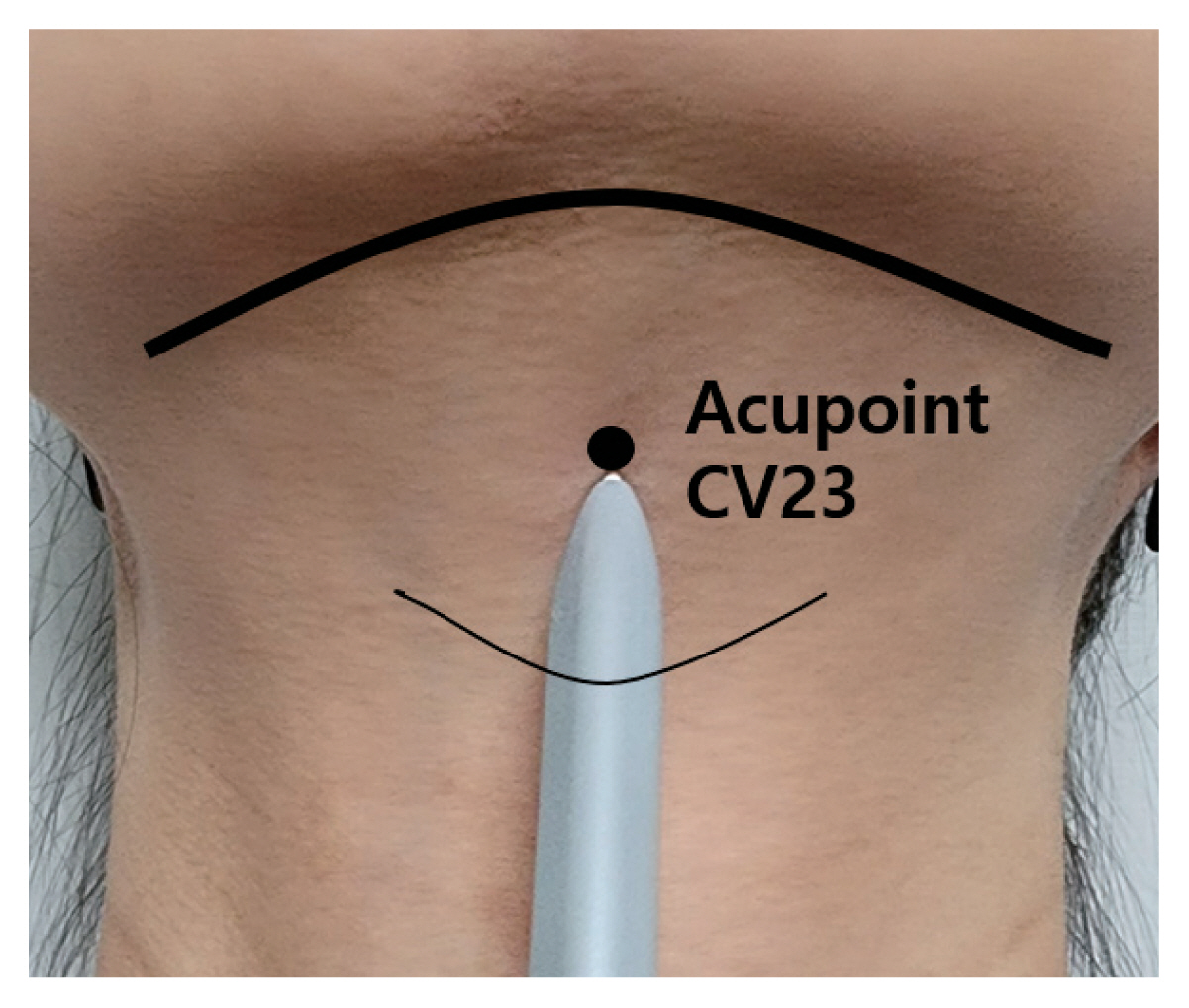
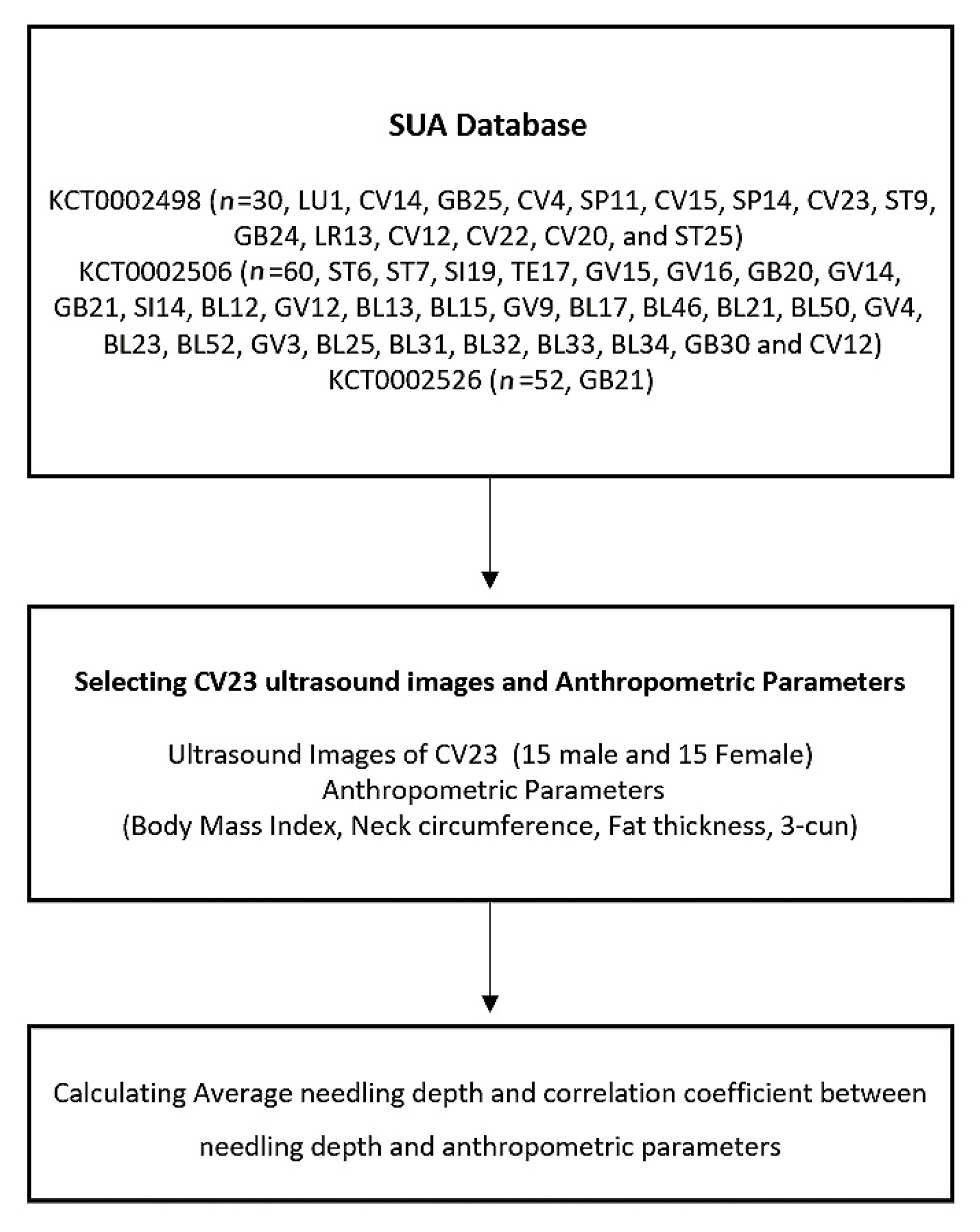
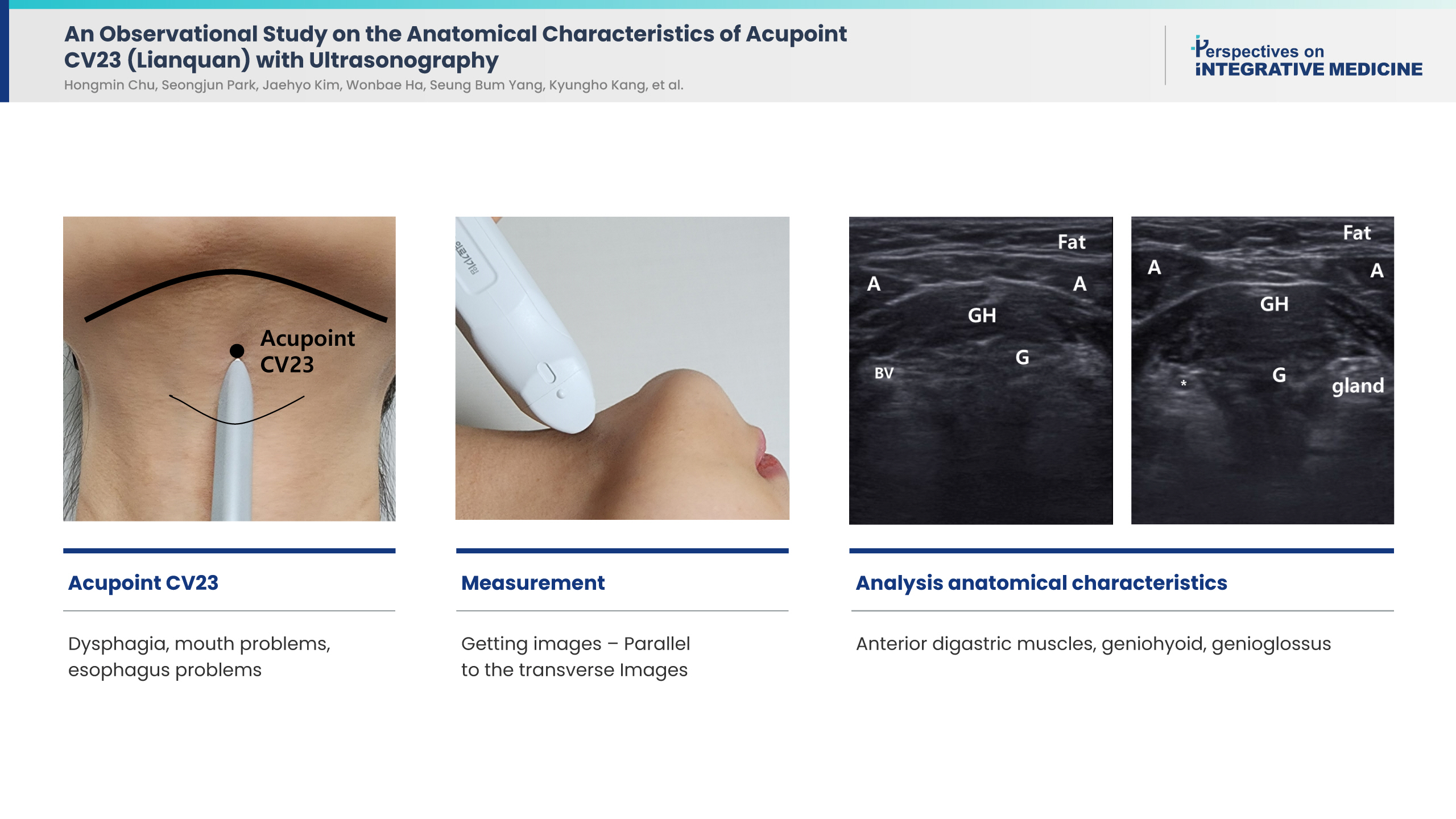

 PubReader
PubReader ePub Link
ePub Link Cite
Cite





